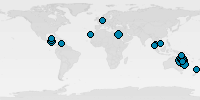
The Torres Strait is a collection of cays, islands, reefs and atolls between the northern tip of Australia and Papua New Guinea with excellent diving.
| Inserted/Added by: | lars, © Author: Lars Hemel |
| Rated: | Rated 3.7, 15 votes |
Send us your images for this dive region[Add Image][Add Movie]
Best dive-season / How to get there: The best time to dive the Torres Strait is between August and December, with water temperatures of 29 degrees year around.The Torres Strait consists out of hundreds of islands, inlets, shoals, cays and reefs. It lies between Australia, Papua New Guinea and Indonesia and is remote diving at its best. Diving is only accessible by live-aboards that usually start at Lockhart River, about halfway between Cairns and Cape York. You can dive at the shipwrecks in the Cape York Peninsula, next to superb drop-offs and it is one of the best places for exploration dives, meaning not many divers have dived here before you. It has been discovered in 1606 by Luis Vaez de Torres and later, in 1774, by Captain James Cook. Officially, it belongs to Australia, but most inhabitants are Aboriginal and Torres Strait Islanders, a mixture between Papuans and Melanesian settlers. Some of the more popular islands are Horn Island (with its WWII airbase), Hammond Islands, Thursday Island and Prince of Wales Island which is separated from the main land by the Endeavour Strait.
Situated between the Coral Sea and the Arafura Sea, the Torres Strait has always been a hazard for boats. The RMS Quetta is without doubt the most popular shipwreck in this shallow shipping lane. This fantastic passenger liner sank in 1890 just south of Mount Adolphus Island. Visibilities at the inner reefs can be below 15 meters, but the strong currents provide for rich waters filled with marine life. The channels near the outer reefs can have visibilities far above 30 meters. Here, where fishing is controlled, you will find huge fish such as large pelagic, mantas and sharks.
[Add Message]Messages from readers:
[Add Divelog]Divelogs from members:
